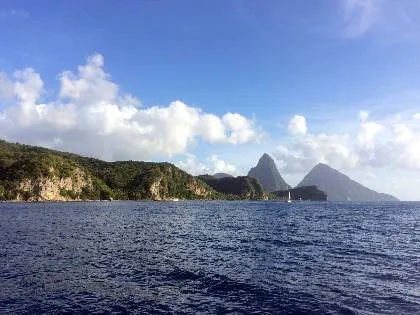Each Winter Break, while many college students head to tropical destinations for some much needed rest and relaxation, 20 UVM students and two professors head to the Caribbean for another reason — community development through service-learning.
Since 2003, the UVM Department of Community Development and Applied Economics (CDAE) and the St. Lucian Ministry of Commerce have engaged in a mutually beneficial partnership (which has expanded over the years to include the Ministry of Education, Innovation, Gender Relations & Sustainable Development), facilitating connections between local schools and, most recently, the Piton Management Area, a UNESCO World Heritage Site.
Professors DeSisto and Kevin Stapleton recognize the importance of conducting community development with the chief goal of building the capacity of the community to take action on their own priorities, and the course itself has evolved to meet the changing needs and desires of the partners in St. Lucia since the first team of UVM students and faculty visited in 2004. "Project planning revolves around what St. Lucians would like to see happen," explains DeSisto. "In all of these projects, the core part of it is community development — helping the people in that given community develop the capacity to take their own action on the things that they want."
The goal not simply to complete a project, but to help partners figure out how to enact what they would like to accomplish. The course facilitates the development of this capacity by sharing expertise, conducting research for the Ministries, and equipping UVM students with the skills and knowledge necessary to advance short-term priorities that the community has identified.
In the past five years that DeSisto and Stapleton have been leading the course, they have focused on working with both the Ministry of Commerce and local schools. Continuing to build connections with the same community partners, year after year, has allowed the relationship between the CDAE department and the St. Lucian institutions to develop trust and reciprocity in their ongoing work. While some aid organizations come and go at will, CDAE can be depended upon to return every year. Consistency is key — for both parties — in building and maintaining the relationships necessary to benefit both the St. Lucian partners and the UVM students.
"The partnership between the University of Vermont and the Ministry of Commerce & Government of St. Lucia started way back in 2003, and this has assisted us very well," says Lyra Thomas-Joseph, who works in the St. Lucia Ministry of Commerce. "The department is looking to continue that relationship and even to broaden the scope."
Although the partnerships develop in St. Lucia, their benefits are no less tangible for the students involved, who experience both detailed project planning in the classroom and actual project implementation out in the real world. This hands-on approach, throughout the course of a semester, offers students the opportunity to both learn and do community development. Students gain a functional skill set, learned and practiced in the field.
While the two professors take the lead in the classroom, students are largely self-directed once they arrive in St. Lucia. The class of 20 divides into their project groups of four and students disperse to work with their partners. After a semester of preparation, students are well-equipped to work independently with their community partners, tackling challenges and testing their skills in real time. "It puts you out in the field," explains UVM student Zach Lewellyn. "You're not there with your professors; you're doing the work, you're talking to the locals and the tourists, and it's on you to get it done."
Melissa Abbott, a Community & International Development major, illustrates how this independence defined her experience. Melissa and her project group worked with the Riviere Doree Anglican School to revitalize their existing garden space. After the initial introduction between the group and the project partners — Riviere Doree’s principal, the head of the lunch program, and a teacher leading the agricultural club — Melissa and her group worked and communicated directly with the school. Each morning, she recounts, the groups split up and spread across the island for their respective projects, only returning to the rest of the class in the evening for a reflective period. While their professors were accessible for questions or concerns as needed, the group worked independently and unsupervised each day. They designed a curriculum and worked with their partners to offer Riviere Doree students hands-on lessons about gardening, composting, and nutrition.
It's this combination of independence and being part of being part of a long-standing, reciprocal partnership — along with the opportunity to experience life on a beautiful Caribbean island — that has made the course so popular and valuable to UVM students. "The longevity is what makes this such a successful project," says Molly O'Shea ’17. "Doing service work abroad often feels unsustainable to me, but seeing the ties that Thomas and Kevin have with this community, and the respect of such a mutually beneficial partnership, made me understand the importance of this work. I feel I have done a fair amount of service-learning during my time at UVM, and I can honestly say that this was one of the most valuable service-learning experiences I have had."
